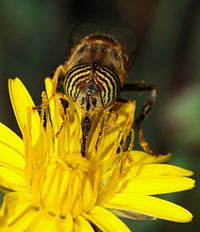
Photo from wikipedia
Mating activities change within a season in many animal and plant populations. In plants, selection towards early flowering is commonly observed. Pollinator-mediated selection is hypothesized to be a pervasive evolutionary… Click to show full abstract
Mating activities change within a season in many animal and plant populations. In plants, selection towards early flowering is commonly observed. Pollinator-mediated selection is hypothesized to be a pervasive evolutionary force acting directionally on flowering time. However, pollinator-mediated mechanisms have rarely been tested in realistic field conditions, especially in perennial plants visited by a diversity of generalist insect pollinators. We examined pollinator visitation in eight Echinacea angustifolia populations in western Minnesota, USA, to gauge the potential for pollinator-mediated selection. Echinacea is a common prairie perennial that persists in isolated remnant populations. Echinacea is self-incompatible and is pollinated by a diversity of generalist solitary bees. A previous study found that early flowering Echinacea plants have higher seed set and their reproduction is less pollen-limited than late flowering plants. Twelve times throughout a flowering season, we quantified pollinator visitation rates and pollinator community composition. In three sites, we also estimated the quality of pollinator visits by examining the composition of pollinators’ pollen loads brought to Echinacea plants. We found that three aspects of pollination dramatically decreased over the course of the flowering season. 1) Pollinators visited early flowering plants more frequently than late flowering plants. 2) The pollinator community was also less diverse late in the flowering season and became dominated by a single species of small bee, Augochlorella aurata. 3) Pollinators visiting Echinacea late in the season carried proportionally less conspecific pollen compared to pollinators visiting Echinacea early in the flowering season. Understanding within-season dynamics of pollination helps predict the prevalence of inbreeding, phenological assortative mating, and reproductive failure, especially in fragmented plant populations.
Journal Title: Oikos
Year Published: 2018
Link to full text (if available)
Share on Social Media: Sign Up to like & get
recommendations!